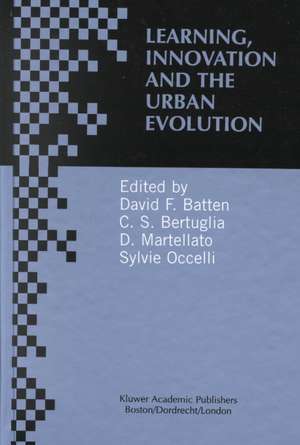Learning, Innovation and Urban Evolution
Editat de David F. Batten, Cristoforo Sergio Bertuglia, Dino Martellato, Sylvie Occellien Limba Engleză Hardback – 30 iul 2000
Our research confirms that we are presently in the midst of an era of rapid and explosive change. The primary engine driving this latest transformation of the post-industrial society is generally thought to be technological. But such an explanation is too narrow. Broadly speaking, the age in which we find ourselves could be more aptly described as a global, knowledge-intensive age. Many of today's knowledge-intensive activities, like research and development (R&D) programs, are being conducted with relative ease on a multinational scale. As well as science having an increasing impact on processes of innovation, R&D activities also have become more complex. We can observe a growing sophistication of learning-by-doing among creative economic agents. This more sophisticated era of global knowledge exchange is facilitated by major advances in our infrastructure networks. In this highly interactive world, many innovations are by-products of collective exchanges between cities far apart, simplified by the ease of transport and communication. Thus, there is a need for us to look more closely at various collective sequences of learning, knowledge exchange and innovation in a spatial setting. This is the primary purpose of this book.
| Toate formatele și edițiile | Preț | Express |
|---|---|---|
| Paperback (1) | 945.92 lei 43-57 zile | |
| Springer Us – 10 oct 2012 | 945.92 lei 43-57 zile | |
| Hardback (1) | 952.09 lei 43-57 zile | |
| Springer Us – 30 iul 2000 | 952.09 lei 43-57 zile |
Preț: 952.09 lei
Preț vechi: 1161.08 lei
-18% Nou
Puncte Express: 1428
Preț estimativ în valută:
182.24€ • 198.02$ • 153.18£
182.24€ • 198.02$ • 153.18£
Carte tipărită la comandă
Livrare economică 21 aprilie-05 mai
Preluare comenzi: 021 569.72.76
Specificații
ISBN-13: 9780792385776
ISBN-10: 0792385772
Pagini: 310
Ilustrații: XI, 310 p.
Dimensiuni: 155 x 235 x 19 mm
Greutate: 0.64 kg
Ediția:2000
Editura: Springer Us
Colecția Springer
Locul publicării:New York, NY, United States
ISBN-10: 0792385772
Pagini: 310
Ilustrații: XI, 310 p.
Dimensiuni: 155 x 235 x 19 mm
Greutate: 0.64 kg
Ediția:2000
Editura: Springer Us
Colecția Springer
Locul publicării:New York, NY, United States
Public țintă
ResearchDescriere
In the global information society, innovation is a highly pervasive process that influences all facets of human life: cultural, economic, political, and institutional. A desire to comprehend the impacts of innovative change on so many areas of urban life prompted the research project that has resulted in the publication of this volume.
Our research confirms that we are presently in the midst of an era of rapid and explosive change. The primary engine driving this latest transformation of the post-industrial society is generally thought to be technological. But such an explanation is too narrow. Broadly speaking, the age in which we find ourselves could be more aptly described as a global, knowledge-intensive age. Many of today's knowledge-intensive activities, like research and development (R&D) programs, are being conducted with relative ease on a multinational scale. As well as science having an increasing impact on processes of innovation, R&D activities also have become more complex. We can observe a growing sophistication of learning-by-doing among creative economic agents. This more sophisticated era of global knowledge exchange is facilitated by major advances in our infrastructure networks. In this highly interactive world, many innovations are by-products of collective exchanges between cities far apart, simplified by the ease of transport and communication. Thus, there is a need for us to look more closely at various collective sequences of learning, knowledge exchange and innovation in a spatial setting. This is the primary purpose of this book.
Our research confirms that we are presently in the midst of an era of rapid and explosive change. The primary engine driving this latest transformation of the post-industrial society is generally thought to be technological. But such an explanation is too narrow. Broadly speaking, the age in which we find ourselves could be more aptly described as a global, knowledge-intensive age. Many of today's knowledge-intensive activities, like research and development (R&D) programs, are being conducted with relative ease on a multinational scale. As well as science having an increasing impact on processes of innovation, R&D activities also have become more complex. We can observe a growing sophistication of learning-by-doing among creative economic agents. This more sophisticated era of global knowledge exchange is facilitated by major advances in our infrastructure networks. In this highly interactive world, many innovations are by-products of collective exchanges between cities far apart, simplified by the ease of transport and communication. Thus, there is a need for us to look more closely at various collective sequences of learning, knowledge exchange and innovation in a spatial setting. This is the primary purpose of this book.
Cuprins
Preface. Acknowledgement. 1. Learning, Innovation and Urban Evolution: An Introduction; D.F. Batten, et al. Part I: Learning and Knowledge Exchange. Section A: Theories of Learning and Complex Dynamics. 2. Innovation and Patterns of Learning: A Survey of Evolutionary Theories; M. Cimoli, M. della Giusta. 3. Emergence and Co-Evolutionary Learning in Self-Organised Urban Development; D.F. Batten. 4. Nonlinear Dynamics, Innovation and Metropolitan Development; D.S. Dendrinos. Section B: Path-Dependent Processes of Knowledge Exchange. 5. the Knowledge-Intensive Nature of Japan's Urban Development; K. Kobayashi, et al. 6. Interurban Knowledge Networks; M.J. Beckmann. 7. Innovation and Urban Planning; B. Harris. Part II: Innovation and Its Spatial Impacts. Section C: Economic and Technological Changes. 8. Product Vintages and Specialisation Dynamics in a Hierarchical Urban System; U. Forslund, B. Johansson. 9. The Impact of Research Activities on the European Urban System; S. Magrini. 10. Is the Real Exchange Rate Relevant for Determining the Innovation Potential of European Regions? D. Martellato. Section D: Impacts of Innovations in Telecommunications and Transport. 11. Impact of the New Information Technologies on Economic-Spatial Systems: Towards an Agenda for Future Research; C.S. Bertuglia, S. Occelli. 12. Telematics Innovation and the Development of Non-Metropolitan Areas: Lessons from Policy Experience; A. Gillespie, R. Richardson. 13. The Impact ofInnovations in Telecommunications and Information Systems on Urban Mobility; E. Cascetta, B. Montella. Index. List of Contributors.















